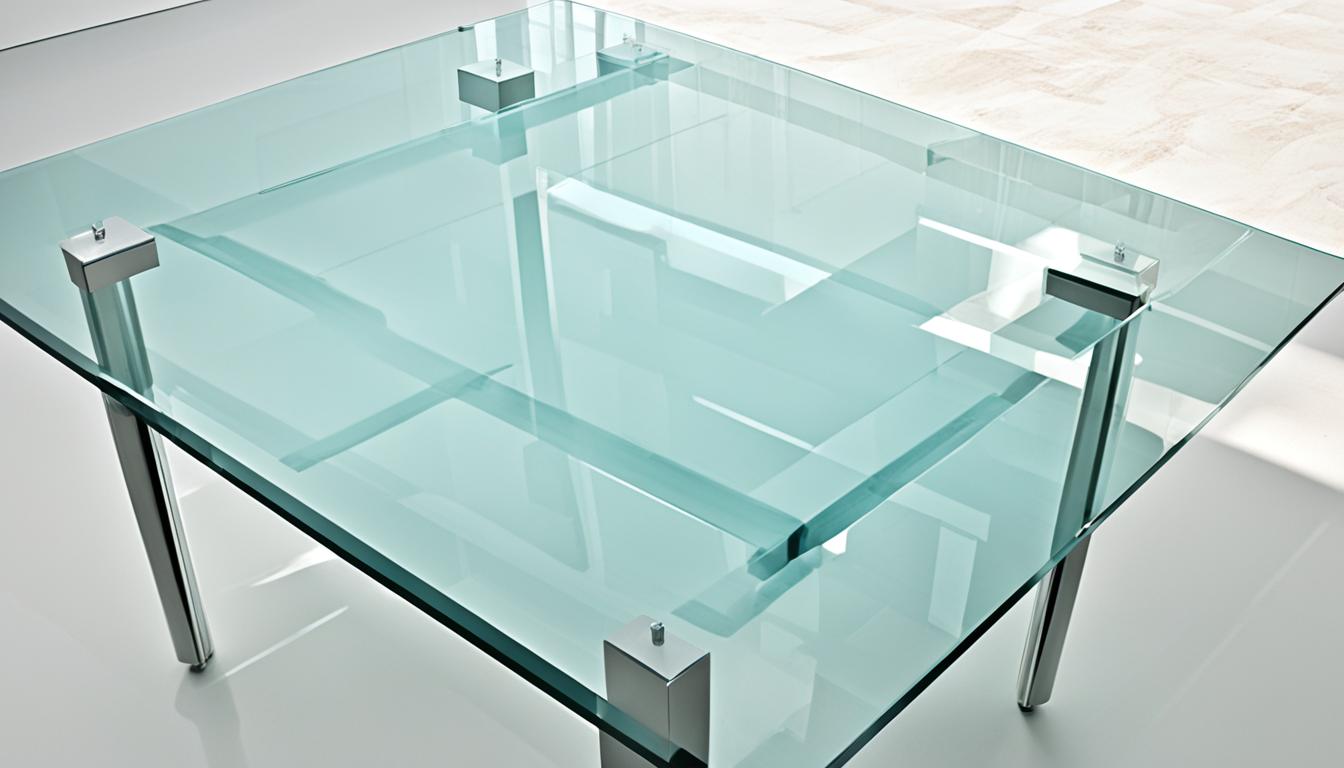Ever wondered why some glass table tops break into small pieces while others shatter into sharp shards? Choosing the right glass for your table top is more than just about looks. It’s about safety, durability, and whether it’s right for busy or risky spots.
When picking a glass table top, knowing the differences is key. You might be looking at tempered glass, basic annealed glass, or laminated glass. Tempered glass is strong and safe, but it costs more. Annealed glass is cheaper but not as safe. Laminated glass is durable and safe, perfect for certain uses.
Each glass type has its own benefits. So, it’s important to pick the right one for your needs.
Key Takeaways
- Tempered glass is stronger and safer than annealed glass, great for busy places.
- Tempered glass might be pricier, but its durability makes it worth it.
- Annealed glass is cheaper but not as safe; it’s best for less risky areas.
- Laminated glass is both durable and safe, making it good for many uses.
- The thickness of the glass, from 3/8″ to 1/2″, affects the table’s look and feel. Thicker glass is better for tables without support.
Exploring Various Glass Table Top Options
There are many custom glass table tops to choose from, each with its own special qualities. Knowing what each type of glass offers can help you make a smart choice.
- Frosted Glass: This glass is clear but not too clear, thanks to sandblasting or acid etching. It lets light through but keeps things private. It’s a favorite for its classy look in dining and conference areas.
- Textured Glass: Made when glass is still molten, it has cool patterns like waves or shapes. It’s great for coffee and accent tables because it adds a unique touch.
- Low-E Glass: This glass has a special coating that keeps it cool in the sun. It’s perfect for outdoor tables and saves energy in busy places.
- Scratch-Resistant Glass for Table Tops: This glass is tough and keeps looking new, even with lots of use. It’s perfect for coffee and office tables.
Choosing the right glass thickness depends on how you’ll use it. For example, 1/4” is good for covers, while 3/8” or 1/2” works better on pedestals. The edge style, like flat polish, can also change how the glass looks.
How strong the glass is matters a lot. Annealed glass is okay for simple protection, but tempered glass is safer, especially with kids around. When using glass in metal frames, make sure it meets the manufacturer’s standards.
Glass table tops can be used in many ways, like protecting wood or as standalone pieces. Each use needs the right thickness and type of glass for both looks and function. For example, coffee tables might just need 1/4” glass, while dining and patio tables might need more.
Choosing the right glass table top is all about looks, function, and safety. Whether you want frosted glass for privacy, textured glass for style, or Low-E glass for energy savings, there’s a perfect match for every need.
What type of glass is best for a table top?
Finding the right glass thickness for table tops is key for both looks and function. The table’s purpose and how much it will hold are important. For example, a protective glass top might use 1/4″ glass. But, a dining table might need 3/8″ to 1/2″ glass for more strength.
The durability of glass for table tops depends on several factors:
- Table Base Strength: Make sure the table base can hold the glass’s weight. For instance, going from 1/4″ to 3/8″ glass increases the weight from 114 lbs to 171 lbs.
- Load Distribution: Splitting the glass into sections, like three pieces, lowers each piece’s weight to about 57 lbs.
- Aesthetic and Safety Aspects: A glass edge that sticks out slightly by about 1/8th of an inch can make the table look better. Think about edge types like flat polish, pencil polish, or beveled polish for different looks.
For protecting tables, annealed glass is often recommended. But, for homes with kids or lots of people, tempered glass is safer. It’s about four times stronger than annealed glass.
Here are some specific things to consider:
- Furniture Protectors: Use 1/4″ thick glass, but 3/8″ or 1/2″ glass can add more protection if the furniture can handle it.
- Glass atop Pedestals: Choose 3/8″ or 1/2″ tempered glass for both stability and safety.
- Metal Frame Replacements: Follow the manufacturer’s instructions, usually picking 1/4″, 3/8″, or 1/2″ tempered glass for strength.
Choosing the right glass thickness is about mixing looks and practical needs. This ensures a table that’s both strong and beautiful.
Conclusion
Choosing the right glass for table tops is a mix of looks, function, and safety. Knowing the perks of each glass type helps make better choices. Tempered glass is top-notch for its toughness and safety features.
It’s about four times stronger than regular glass and breaks into small, dull pieces. This makes it perfect for places that get a lot of use or might get hit.
Laminated glass is also great. It keeps broken pieces together, making it safer for homes with kids or pets. The right glass thickness is key for each table type.
Dining tables do well with 1/4″ to 1/2″ thickness, with 3/8″ being the sweet spot. Patio tables might need up to 1/2″ for harsh weather.
Getting professional glass installation is a smart move. Experts have the right tools and know-how for a job well done. They ensure your glass table lasts long and works well.
Listening to interior designers or glass experts can help pick the best edge styles. This boosts both safety and looks. Remember, proper care and maintenance keep your glass table looking and working great for years.





